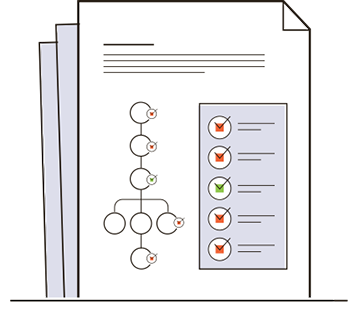Process Audit
What is a process audit and how can it help improve operations?

What is a business process audit?
A process audit is an internal audit that looks at how a business operates and identifies areas of improvement in its business processes.
What are the expected outcomes?
The audit can help identify inefficiencies, areas of risk, and potential opportunities for improvement. The audit results can help create a plan to improve operations and increase efficiency.
How is an audit performed?
The audit is performed by examining documents, interviewing staff, and observing operations to assess the effectiveness of processes.
Build the Team
PricewaterhouseCoopers found that 60% of businesses understand that cooperation between different departments is necessary to reach their goals. This is also true of process audit teams. Create an audit committee composed of cross-functional coworkers who are familiar with the audited process and some less familiar who can offer objective, outside feedback and ask questions that help reframe process elements.
Get Leadership Buy-In
Include management from the very beginning of the audit planning process. This will give you the backing and resources to build the team, schedule the time, and communicate more effectively. While a grassroots effort may get you started, you'll need help from leadership to be practical.
Ensure that the audit team has the proper resources and access to the information needed to conduct the audit and involve the audit members in the decision-making process. Develop a timeline for the audit process and set expectations for the deliverables.
Identify any risks or areas of concern before starting the audit and ensure that these are addressed during the process. Finally, ensure that feedback is provided to the audit team and that any changes or recommendations are implemented promptly.
Establish Goals and Metrics
Explain the goals of your audit program to both the process stakeholders and management sponsors. Formalize the goals in writing. Perhaps the goal is a 10% increase in productivity or a reduction of errors by 20%. Goals should be realistic but impactful.
You'll also need to determine the metrics that will be reviewed as part of the audit and later as part of the performance review after changes have been made. They should be objectively measurable and relevant.
Check out our blog post, "Process Metrics and KPIs Explained," for specific ideas on developing your metrics smartly.
Use Checklists
To ensure all the proper steps are taken during an audit, it's a good idea to create an "audit checklist" for the audit team to walk through for each process.
For instance, you could build a checklist around these topics:
- The primary business goals of the process
- The non-negotiable constraints placed on the process
- The strengths and weaknesses of the process as currently performed
- Where mistakes happen most often
- Where are redundancies
- The training provided to process stakeholders and participants
For more ideas, check out our BPM Guide.
Plan the Future State
There is both an art and a science to planning a process's future state. There are metrics and complex data that can help set proper goals, such as "Reduce hand-off time between Task A and Task B from the current 2 days to 6 hours." However, there is also an element of creativity when discussing changes in how the future state can be achieved.
Interviews with process owners and process participants can unearth many of these answers. Make the interviews a safe space for open dialog. Consider one-on-one consultation to allow interviewees to speak truthfully and openly about the good, the bad, and the ugly regarding the process and their vision of a better process.
Collect all the data points and ideas and work with the stakeholders to determine how the process should work. This will require a series of meetings to achieve consensus. Be patient. The end product will then need to get management buy-in.
Once you have settled a future state, evaluate management systems to lay out and optimize the process for real-world use. This will usually mean a combination of automated and human tasks.
What are some examples of processes that can be audited?
IT/IS
New Account Setup
Finance
Expense Approvals
Salary/Wage Changes
Marketing
Campaign Approvals
Brand Management
Facilities
Office Relocations
Resource Scheduling
Facility Access
Move Requests
Sales
Quote Approvals
Pricing Discounts
Proposal Approvals
Product Discounts
Legal
Legal Holds
HR
Benefits Changes
Vacation Requests
Purchasing
Product Pricing
Operations
Maintenance Request
New Product Request
FAQs About Process Auditing
What are the biggest roadblocks to a successful audit?
The biggest roadblock will ultimately be getting accurate information during the audit. Process members will naturally want to protect their roles and performance. Work hard at making interviews safe and open.
Explain that the goal is to make work easier and give staff more time to focus on valuable work. Encourage interviewees to share their experiences and knowledge.
What qualifications do I need to run an audit?
Anyone can run a process audit, but the best process auditors think innovatively, are interested in details, act ethically, and are good at communicating both individually and within a team.
What do I do if there is no process documentation to review?
In the best scenario, the process you will be auditing has already been documented. However, in many cases, the process documentation is poor or nonexistent. The audit team can either rely on the process stakeholders to document the process or step in and do it.
Our article, "How to Write Process Documentation, " discusses the best practices for creating usable process documentation.
Interested in Automating Your Process?
We have a library of resources to help you on your journey to an automated workplace.

